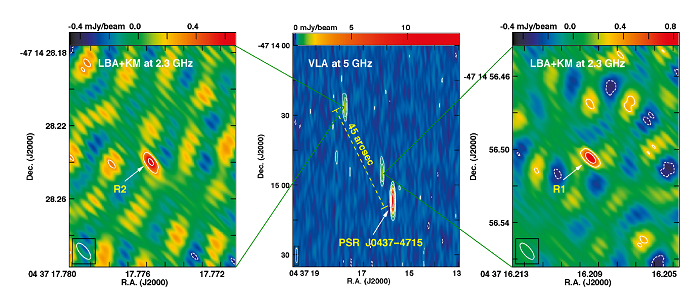The compact radio cores of distant galaxies can be used not only to reveal the existence of supermassive black holes, but also to provide stationary reference points to accurately measure the distances of nearby pulsars on the sky plane. Applying this method, Very Long Baseline Interferometry (VLBI) observations, which consist of radio telescopes around the world, can accurately measure the periodically positional variations of Galactic pulsars, namely the annual parallax, and then derive the parallax distance.
Recently, PhD student LI Zhixuan (Yunnan Observatories, P.R. China), Dr. YANG Jun (Onsala Space Observatory, Sweden), Dr. AN Tao (Shanghai Astronomical Observatory, China) et al. have discovered two extra-galactic compact radio cores with separations of less than one arcminute to the famous millisecond pulsar PSR J0437–4715. The two radio cores would be excellent reference points to accurately measure this pulsar’s distance. The results have been published in the British journal Monthly Notices of the Royal Astronomical Society.
The discovery is not only extremely lucky (probability: about one thousandth), but also allows their subsequent VLBI observations of the annual parallax to reach an accuracy of around 1 light year (about 0.2% of its distance). Furthermore, because this millisecond pulsar is one of the most stable pulsars in the timing observations, the time stability of the Newton's gravitational constant G can be investigated by comparing the VLBI parallax distance with the kinematic distance, which is sensitive to the time variability of G and can be measured separately from the timing observations of the binary system. Therefore, this finding would also help to achieve a more stringent constraint on the time stability of G.
This result is the fruit of the first collaborative observations between the Yunnan Observatory 40-meter radio telescope and the Australian VLBI network (LBA). In this study, the Kunming 40-meter radio telescope uniquely provides the high-sensitivity data on the baselines longer than 6,000 kilometers and thus plays a key role.
Because of the compact structures, the small differences in the flux densities measured at multiple frequencies( i.e. optically thick radio spectra) and the long-term stable fluxes, they are most likely the compact radio cores in the nuclei of the extragalactic galaxies. Given that these three radio sources are extremely close to each other, they can be observed simultaneously at relatively higher frequencies with just one set of VLBI equipment. In the subsequent data reduction process, the bright pulsar can be used as the calibrator. With the differential calibration, all the systematic errors would be eliminated and the relative positions can be accurately measured. In the near future, if broad-band (not less than 4GHz) observations are available, the position measurement accuracy would exceed the current observation limit (about ten micro-arcseconds).

The left and right panels show the VLBI detections of the two sources R1 and R2, respectively. On the sky plane, the angular distances from PSR J0437–4715 to the two sources are 13 arcseconds and 45 arcseconds(Image by LI Zhixuan and YANG Jun)
Contact:
LI Zhixuan, lzx@ynao.ac.cn, Radio Astronomy Group,Yunnan Observatories
YANG Jun, jun.yang@chalmers.se, Onsala Space Observatory
AN Tao, antao@shao.ac.cn, Shanghai Astronomical Observatory